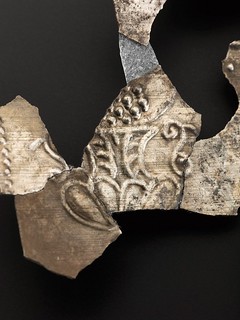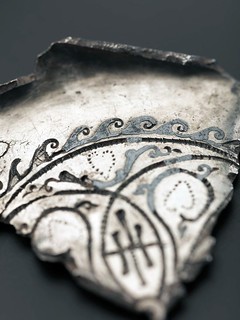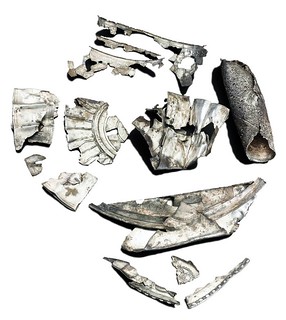
PREV ARTICLE
NEXT ARTICLE
FULL ISSUE
PREV FULL ISSUE
MORE ON THE DAIRSIE HACKSILVER HOARDRemembr the Dairsie hoard of late 3rd century hacksilver discovered last year? Archaeologists have been working to put the piece back together. Here's an excerpt from a Current Archaeology article. -Editor
What is hacksilver? It is a term used for items, mostly silver vessels, which have been deliberately cut, chopped, and crushed into fragments – converted from beautiful works of art into a weight of silver. Although this habit has a long pedigree in the Old World, our main interest is with the Roman period. The work of the late Kenneth Painter in particular has shown that this was no barbarian habit: hacksilver is found on both sides of the Roman frontier, especially in the north-western provinces, from the 2nd century AD to the 6th, though with a strong focus in the 4th and 5th centuries. Kenneth also showed that this silver was treated as bullion: much of it clearly correlated to multiples or fractions of Roman pounds and ounces, indicating the use of Roman weight standards. Either our barbarians were terribly careful with their brutal hacking, or there was a Roman economic motive behind this process – hacksilver was a process of turning objects into bullion at times of need. One of those needs was dealing with barbarians. Hacksilver was sent north, whether as diplomatic gifts or payments for mercenary services, to Ireland, Denmark, the Netherlands, as far as Ukraine – and to Scotland. For a long time, this ‘barbarian’ hacksilver was seen as a phenomenon of the late 4th and 5th centuries AD. The new Fife find changes this. For the first time, we can see this policy of bullion payments starting earlier, in the late 3rd century.   PIECES OF SILVER The final vessel is the most remarkable, but also the most difficult to reconstruct. It was made from thin, highly fragile silver, and seems to have been carefully placed, intact and upside down, to act as a cap to cover the rest of the silver. Unfortunately, this arrangement left it extremely vulnerable to the plough, and the base has been almost totally lost, but most of the rim survives. To read the complete article, see: To read the earlier E-Sylum article, see:  Wayne Homren, Editor The Numismatic Bibliomania Society is a non-profit organization promoting numismatic literature. See our web site at coinbooks.org. To submit items for publication in The E-Sylum, write to the Editor at this address: whomren@gmail.com To subscribe go to: https://my.binhost.com/lists/listinfo/esylum All Rights Reserved. NBS Home Page Contact the NBS webmaster 
|
